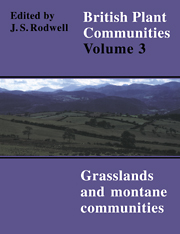Book contents
- Frontmatter
- Contents
- List of Figures
- Preface and Acknowledgements
- Preamble
- Mesotrophic Grasslands
- Community Descriptions
- Calcicolous Grasslands
- Community Descriptions
- Calcifugous Grasslands and Montane Communities
- Community Descriptions
- Index of Synonyms to Grasslands and Montane Communities
- Index of Species in Grasslands and Montane Communities
- Bibliography
MG9 - Holcus Lanatus-Deschampsia Cespitosa Grassland
Published online by Cambridge University Press: 04 July 2020
- Frontmatter
- Contents
- List of Figures
- Preface and Acknowledgements
- Preamble
- Mesotrophic Grasslands
- Community Descriptions
- Calcicolous Grasslands
- Community Descriptions
- Calcifugous Grasslands and Montane Communities
- Community Descriptions
- Index of Synonyms to Grasslands and Montane Communities
- Index of Species in Grasslands and Montane Communities
- Bibliography
Summary
Synonymy
Deschampsietum caespitosae Horvatic 1930 p.p.; Arrhenatheretum elatioris deschampsietosum caespitosae LeBrun et al. 1949; Tussocky neutral grassland Duffey et al. 1974; Juncus-Carex hirta-Deschampsia cespitosa nodum Wheeler 1975 p.p.; Moist Deschampsia-Dactylis grassland Rahman 1976; Ordinary wet meadows Ratcliffe 1977; Festuco-Alopecuretum pratensis deschampsietosum caespitosae Page 1980.
Constant species
Deschampsia cespitosa ssp. cespitosa, Holcus lanatus.
Physiognomy
The Holcus lanatus-Deschampsia cespitosa community has a coarse sward dominated by D. cespitosa and other large tufted or tussocky grasses, Holcus lanatus, Dactylis glomerata and Arrhenatherum elatius. The physiognomy and composition of the vegetation are somewhat varied but depend largely on the number, size and disposition of tussocks of D. cespitosa and on their pattern of aerial growth through the year. In closed, stable swards like the vegetation of this community, D. cespitosa maintains itself by the vegetative expansion of clonal individuals, each of which may come to comprise several thousand tillers arranged in a densely-caespitose tussock. Although the tillers themselves are short-lived, with a continual turnover and gradual accumulation of dead material, whole tussocks may attain a considerable age, perhaps 30 years or more. As they grow, the tussocks do not extend their ground cover greatly but they are able to produce an increasing spread of aerial shoots each year and these may attain a height of 50-200 cm in older, well-grown individuals. There is a maximum proportion of live material in a tussock in August, after which there is extensive die-back although many leaves remain winter-green and there may also be some slow new growth during the winter (Davy 1980).
The vegetation is generally a mosaic built around the D. cespitosa tussocks. Where these are scattered, there is between them a sward, often cropped short by preferential grazing, in which Holcus lanatus, Festuca rubra, Agrostis stolonifera, A. capillaris, Poa trivialis, Dactylis glomerata, Lolium perenne and Alopecurus pratensis may each be locally abundant. Dicotyledons are numerous and varied but none is constant. The most frequent species are Ranunculus repens, R. acris, Cirsium arvense, Rumex acetosa, Cerastium fontanum, Plantago lanceolata, Lathyrus pratensis and Centaurea nigra. The particular combination of these grasses and dicotyledons in the sward between the tussocks is frequently a reflection of the type of grassland in which D. cespitosa has become established.
- Type
- Chapter
- Information
- British Plant Communities , pp. 82 - 87Publisher: Cambridge University PressPrint publication year: 1992

